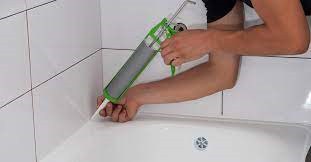When we use showers and baths they generate a lot of steam and a lot of excess water. To stop this from becoming a problem we have tiles and we try to use pvc or porcelain wash basins to reduce the amount of soakage and its effects. Whilst the surfaces are pretty ideal, they need to be bonded to walls and each other. This is where silicone comes in. It forms a watertight bond between the two substances that stops water from seeping into cracks and is an effective glue. It doesn’t get rock hard but it does give a semi spongy seal afterwards.

This is fine but with the constant use of baths and showers it will slowly degrade over time. Once this happens mould and mildew spores can start to take root. If left untreated and ignored the spores will start to reach out to other parts of the bath and begin to flourish. You could end up with a bathroom full of black mould. This is not ideal as it can cause serious lung conditions or exacerbate existing ones. If you have a recurring damp problem you may have a leak or some pipe damage – it is worth getting a professional like this plumber Gloucester based HPR Services in to come and have a look at it for you.

The task of removing the sealant is a daunting one. Simple bleach, effective most of the time, cannot hope to eradicate the mould as it is lurking under the skin of the sealant. The only effective way of removing the mould is to remove the sealant altogether. This can be a painstaking operation as the job is timely. You also need to make sure that you get it all so it does not reoccur. This is where Silicone sealant remover comes in. It’s fast and it’s effective and it does not damage the surface the silicone is bonded to.
